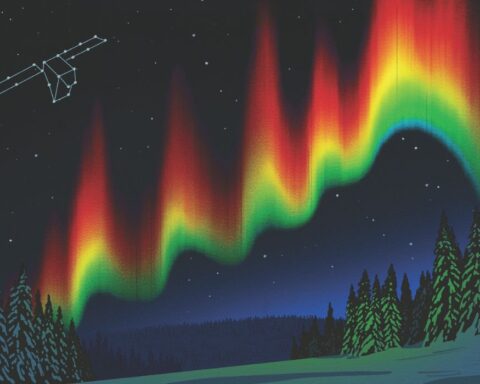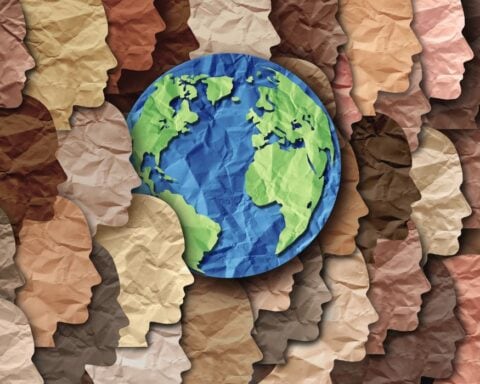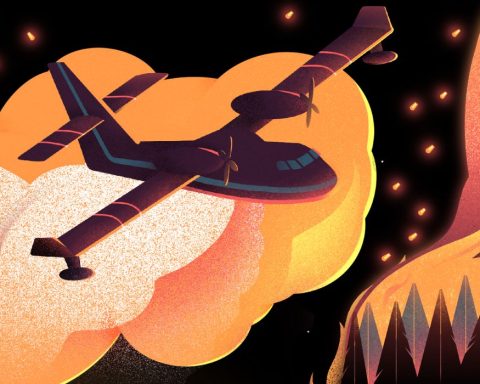From a distance, when you see the white smoke curling up from the forest, you worry. How far away is the fire? Which direction is it heading? From close up, when the flames are rising into the treetops, it’s time to panic.
When wildfires encroached on the outskirts of Fort McMurray the morning of May 3, 2016, the general messaging from officials was “Go about your life as normal.” By noon, as John Vaillant reports in his book Fire Weather: The Making of a Beast, the tune had changed dramatically, to “Everyone out! Now!!” Eighty-eight thousand people fled the city, many carrying traumas that last to this day. Roughly 2,400 homes were destroyed, many in an explosive burst of incinerated fury, because the heat was so extreme. By the time the fire expired 15 months later, it had consumed 5,900 square kilometres of forest and caused $9.9 billion in damage. They called it The Beast.
Fire in the forest is normal; the boreal forest has evolved to burn every hundred years. Spruce fir trees actually wait for fire to release their seeds. But when you consider that eight of the world’s worst wildfire years have happened in the last 10 years, this certainly isn’t normal. This year there have been furiously destructive fires in British Columbia, Alberta, Saskatchewan, Nova Scotia, Ontario, Quebec, Kazakhstan, Sicily, Sardinia, Lombardy, Athens, Corfu, Rhodes, France, Romania, Andalusia, Catalonia, Portugal, Arizona, California, Montana, Oregon, Maui (killing more than 100 people and destroying Lahaina), and now, as I write, Yellowknife. They are even burning in the Arctic.
By early August, 5,500 fires had burned 134,000 square kilometres of Canada’s forests, six times more than the seasonal average, releasing a vast amount of stored carbon. That’s five times the size of Vermont, two and a half times the size of Nova Scotia. In northern B.C., the Donnie Creek fire is the largest ever recorded in the province. Canada has 3.2 million square kilometres of forest, so if this much was to burn every year, it would all be blackened and gone by 2047. All gone.
The climate system is an angry beast, and we are poking at it with sticks.
– Wallace Broecker, oceanographer, paleoclimatologist, 50 years in climate science.
The “beast” is both fire and the climate system. Each fire has a specific local cause, but if we continue to feed the climate beast, increasing the heat and drought conditions that fire thrives on, we can be guaranteed that future fires will be worse, as will the downpours, floods and sea-level rise that the beast also causes. In 2022, a landmark UN report warned that the climate crisis would increase the risk of wildfire by 50% by the end of the century.
As humans, we like our creature comforts. We also like our beliefs, and we are reluctant to admit that we might sometimes be wrong. It’s a matter of pride. If we can persuade ourselves that there is no climate beast, we can continue to enjoy our trucks, our boats, our flights, our vacations, our steaks and our other fossil-fuelled privileges without a guilty conscience. To bolster our belief, we can listen to professors like Jordan Peterson, who will assure us and his millions of followers that any talk of a climate crisis is a hoax designed to take away our cherished personal freedoms.
Meanwhile, the fire keeps coming, and a new word has entered our vocabulary: pyrocumulonimbus. This is fire weather that explodes like a bomb, cauterizing the landscape; devouring houses, cars, trucks and equipment; vaporizing any water that the valiant firefighters might try to send its way.
In Fort McMurray, as Vaillant describes with aching pain in his book, 20,000 of the residents who fled chose not to return, but 68,000 did return to continue feeding the beast, many of them digging bitumen out of the ground, cooking it with two billion cubic feet of natural gas a day, to produce three million barrels of crude oil a day, pumping it into pipelines, all so that we can keep on driving and flying our fossil-fuelled vehicles.
In a few short decades, we have burned our way through fossilized energy that took millions of years to form. We have released all of its stored carbon into the atmosphere, where, as carbon dioxide, it traps heat. As a New Scientist editorial stated in June 2023, “The basic science of climate change is so universally accepted that only the most fringe elements of society now deny it.”
Yet like an alcoholic who insists they are not drunk, many people refuse to talk about it. In Alberta, 53% of those who cast a ballot in the 2023 election voted for the United Conservative Party, made up of politicians who are determined to continue feeding the beast.
Last week, a cold front passed through the province following several days of hot, dry weather. pic.twitter.com/fHbPsizjbr
— BC Wildfire Service (@BCGovFireInfo) August 22, 2023
It’s not just in Canada that people are having this difficulty. In the summer of 2021, the novelist Christy Lefteri flew to a small town on the coast of Greece near Athens to learn about the wildfire that ripped through the town in 2018, killing 80 people and destroying two– thirds of the homes. She wanted to hear people’s stories, to understand what it meant to be displaced by such a disaster. Everyone was distressed, but as soon as she raised the topic of climate change, they made it clear that such talk was “shut down immediately and completely.”
In Lahaina, the historic town in Maui destroyed by an unprecedented blaze, the talk is of drought, hurricane winds, downed power lines, highly flammable non-native grasses, and the absence of warning sirens. After all, how can the myriad climate solutions help the victims of a fire that has come and gone? Far better to focus on prevention by protecting the wildland-urban-interface, fire-proofing people’s homes, and better training for firefighters to limit the damage from the fire beast’s assaults. We have our firefighter and first responder heroes, and our climate heroes are legion, but their efforts are being sabotaged, obstructed, and delayed by those who are addicted.
If we continue to obstruct the climate solutions that can wean us off our addiction and lead us to a green, climate-safe future, the beast will destroy us all. It will burn our forests down, drive us off our farms, flood our homes, increase our torment with its heat, turn us into climate refugees, slowly cook the ocean and make our grandchildren curse us. Then it will melt the ice in Greenland and Antarctica and flood the world far beyond what anyone is expecting.
So please don’t think “I’m glad it’s not my family that was living in Fort McMurray, Lytton, or Lahaina.” The beast will come for all of us. Ask instead how you can be one of the heroes who goes out to fight the climate beast. There is much that you can do:
Have you:
- written to your local, federal and provincial politicians, urging rapid action?
- examined your investments and removed all those that support fossil fuels?
- written to the directors of your bank, urging them to stop financing fossil fuels?
- urged the companies you purchase from (and business friends in C-suites) to rapidly curb their emissions?
- traded in your beast-mobile for an EV, bus or bicycle?
- switched your home’s oil or gas heating to a clean electric heat pump?
- held your children tight, and told them you will do whatever you can to stop the beast?
Guy Dauncey lives in Ladysmith, on Vancouver Island. He is the co-founder of the West Coast Climate Action Network.





